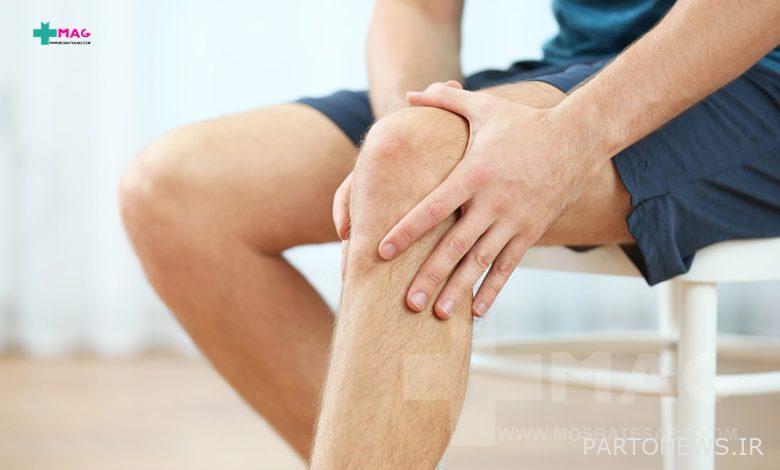Fluid in the knee; Ways of treatment and prevention

One of the most common knee problems is swelling. Statistics show that 27% of people experience the problem of knee swelling at least once in their life. In this article, we will talk with you about the cause, symptoms, treatment and prevention of knee swelling.
What is knee swelling?
A knee effusion occurs when excess fluid collects in or around the knee joint. The most common causes that can cause knee effusion are arthritis and damage to the ligaments or meniscus that make up the cartilage inside the knee.
Symptoms of knee swelling
Excess fluid in the knee causes inflammation of the bony parts of the knee. In this case, one knee may appear larger than the other and it becomes difficult for a person to bend and straighten the knee. Common symptoms of knee effusion include:
- swelling
- stiffness
- Decreased range of motion
The following signs and symptoms require immediate medical attention:
- Inability to use the joint
- Absence of feeling the pulse in the leg area
- Loss of sensation below the knee
- Fever
Other symptoms depend on the underlying cause. For example:
- Osteoarthritis: The feeling of pain and stiffness usually increases in the morning. But it gets better about 30 minutes after waking up.
- Rheumatoid arthritis: Pain and swelling often affect multiple joints. This type of pain often lasts up to 30 minutes after waking up and then decreases.
- Traumatic injury: There may be bruising and severe pain, and it may also be difficult to bear weight on the knee.
- Infection: The knee may feel hot and fever may also be felt.
Cause of knee effusion
Inflammation and swelling can be caused by a traumatic injury, arthritis, or infection. Accumulation of fluid in the knee can cause discomfort and be a sign of a disorder in the body. The type of fluid that collects around the knee depends on the person’s underlying disease, condition, or type of injury or trauma that caused the knee fluid. The doctor may remove some of the fluid and send it to the laboratory for further tests. Tests on fluid from the knee may indicate one of the following:
- A traumatic injury that results in a ligament fracture or injury.
- Arthritis
- gout
- Septic arthritis
- False gout
- Tuberculous arthritis
- Juvenile rheumatoid arthritis
- Overuse of the knee due to certain physical activities or sports.
- Infections such as Lyme disease or syphilis
- Reactive arthritis
- Inflammatory bowel disease
- Hemarthrosis or bleeding in the joint
Overweight and obesity may also increase the possibility of knee swelling by putting pressure on the knee.
Prevent knee effusion
To prevent the accumulation of water in the knee, you should pay attention to the following points:
- Be physically active. Walking and swimming are good options.
- Avoid sudden movements and high-intensity running.
- If possible, avoid repetitive movements on the knee.
- Maintain your ideal weight for your height.
- For chronic conditions such as arthritis, be sure to see a doctor and take the necessary care.

Treatment of swollen knees
The treatment of knee effusion should be done according to the main cause of its occurrence. Therefore, treatment methods can be different for different people. Some of these treatments include:
Aspiration or evacuation
The doctor uses a needle to take out and drain the knee fluid. In this way, the feeling of pain and discomfort will be removed.
Related posts
Corticosteroid injection
If the doctor uses corticosteroid injection for knee effusion, the inflammation will decrease and as a result, the intensity of pain will also decrease.
Non-steroidal anti-inflammatory drugs
Non-steroidal anti-inflammatory drugs without a prescription, as well as those that require a doctor’s prescription, can be an ideal option for pain relief.
Antibiotics
If the cause of knee swelling is related to infection, then the doctor may use antibiotics to fight the infection. When the agent is neutralized, the pain and inflammation also disappear.
Knee brace or splint
In some cases, by buying a knee brace, you can help stabilize the knee joint and relieve the pain.

Antirheumatic drugs
DMARDS can be used long term to help treat rheumatoid arthritis.
Knee surgery or replacement
In some cases, no solution to deal with swelling of the knee is as effective as surgery. Whether or not your knee is an option for surgery can only be determined by a doctor.
Home remedies for swollen knees
Along with medical treatments, self-care is also very important in improving knee effusion. You can try the following solutions:
- Rest your feet
- Keeping the leg up
- Putting ice wrapped in a towel on the knee
- Use of mobility aids such as canes
- Weight management and doing the necessary things to reduce weight (to reduce the pressure on the knee joint.)
- Doing exercises that do not put pressure on the knee joint. Such as: swimming, yoga and tai chi.
Treatment of swollen knees with ginger
In traditional medicine, one of the best ways to deal with swollen knees is to use ginger. For this, you need to dissolve 1 tablespoon of ginger powder in some boiling water to make a paste. You should put this paste on the target area 2-3 times a day and close it. Another way is to use ginger supplement. Research has shown that taking 1 gram of ginger supplement daily can fight inflammatory markers in patients with knee osteoarthritis and relieve pain and inflammation. Ginger is a plant that has excellent anti-inflammatory properties.
Is bringing water to the knee dangerous?
If you notice that your knee is swollen, you should immediately start home remedies. If there is no improvement and the symptoms progress within 1 or 2 days, you should see a doctor immediately. Failure to treat knee effusion causes limitation of knee joint movements and causes atrophy The muscles will be supportive. Knee effusion is not fatal, but since it is very painful, if not treated, it will limit a person’s movements and change their life.
How long does it take for a sprained knee to heal?
The duration of recovery from knee effusion depends on the cause and the course of treatment recommended by the doctor. Experts suggest that treatment be started within the first 24 or 48 hours of the onset of this problem in order to prevent possible complications. But as we said, the time of treatment and complete recovery depends on the cause of this condition and other factors such as the age and overall health of the person. Usually, knee effusions heal permanently after other treatment. But if it is caused by a chronic disease such as arthritis, it may recur in the future.
last word
In this article, we have explained everything you need to know about knee replacement. If you have symptoms of knee effusion, it is better to see a specialist doctor. The treatment of this problem should be done by considering its cause. In many cases, after healing, the problem will be solved forever.
Please rate this article
[مجموع: ۱ میانگین: ۵]


